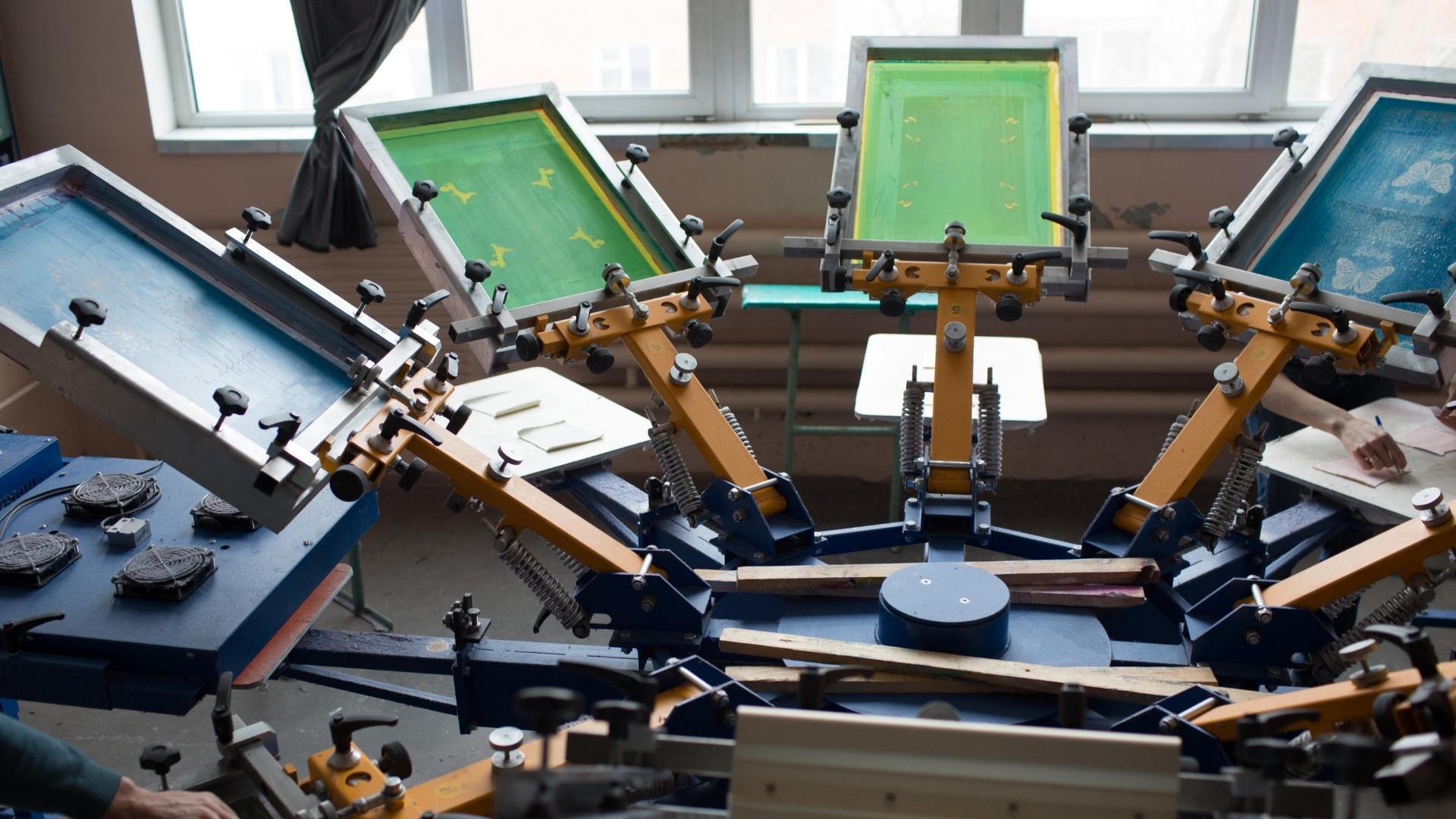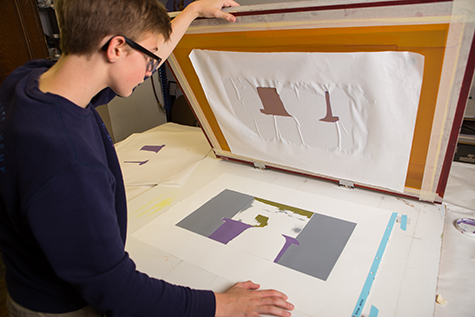Discover the Numerous Kinds Of Screen Printing Techniques for Your Following Job
Screen printing offers a varied variety of strategies that can improve any imaginative project. From typical techniques like serigraphy to modern-day developments such as direct-to-garment printing, each approach has its special advantages. Specialty choices, consisting of metallic and environmentally friendly inks, introduce also much more opportunities. Understanding these methods can greatly affect the last outcome. However, the obstacle depends on choosing one of the most appropriate approach for specific demands and desired impacts. What variables should one think about?

The Fundamentals of Screen Printing
Although screen printing might appear complicated, it is essentially an uncomplicated procedure that entails moving ink via a mesh screen onto numerous surface areas. The method begins with the creation of a pattern, which specifies the style to be printed. This stencil is affixed to a mesh screen, typically constructed from polyester or nylon. As soon as the pattern is in area, ink is used to the screen and pushed through the mesh making use of a squeegee, causing the preferred pattern being printed on the underlying product.
Screen printing can be carried out on a large range of substratums, including textile, plastic, and paper, making it a versatile selection for different tasks. The procedure allows for vivid shades and elaborate designs, making it popular in sectors such as art, style, and advertising. Understanding these essentials gears up people with the foundational expertise needed to discover advanced strategies in screen printing.
Standard Screen Printing Techniques
Typical screen printing methods have actually been employed for centuries, protecting the workmanship and artistry of this technique. This method makes use of a mesh screen to transfer ink onto a substratum, such as fabric or paper, permitting for lively and long-lasting designs. The process begins with creating a pattern, which obstructs certain areas of the screen to regulate where the ink will be used.
One popular technique is serigraphy, typically utilized for creative prints and restricted editions. An additional is using water-based inks, which are environmentally friendly and provide a soft feel on fabrics - 10:9 Design near me. Furthermore, conventional methods can consist of hands-on printing, where artisans apply ink with a squeegee, making certain accuracy and interest to detail
These strategies stay valued in the market for their tactile top quality and the special structures they produce, interesting both consumers and makers that appreciate the heritage of screen printing.
Digital Screen Printing Innovations
As the need for faster manufacturing and personalization in the printing industry has actually risen, digital screen printing innovations have actually arised as a game-changer. This technology blends traditional screen printing methods with electronic processes, permitting rapid prototyping and detailed styles that were formerly tough to achieve. One substantial improvement is the introduction of direct-to-garment (DTG) printing, which assists in premium, full-color prints on various textiles without the need for screens. In addition, developments in ink solutions have brought about environmentally friendly alternatives that preserve vivid colors while decreasing environmental impact. Making use of automated systems even more streamlines production, minimizing labor costs and enhancing precision. These technologies not only deal with tiny set orders and individualized layouts but also enable quicker turn-around times, making them perfect for services concentrated on meeting customer demands in a hectic market. Digital screen printing, subsequently, represents a necessary evolution in the domain of printing techniques.
Specialty Screen Printing Approaches
Discovering specialty screen printing approaches exposes a diverse selection of methods that press the boundaries of imagination and functionality in the printing market. Among these, glow-in-the-dark inks provide an one-of-a-kind aesthetic impact, making designs come to life in low-light conditions. Metallic inks, understood for their sparkling surface, include a touch of Resources luxury to printed products. Another ingenious technique is discharge printing, which gets rid of dye from the fabric rather than including ink, resulting in a soft, classic feel. High-density printing develops an increased texture externally, boosting responsive interaction. Furthermore, water-based inks are acquiring popularity for their vibrant colors and lowered ecological effect. Each of these specialized methods accommodates particular style needs, allowing brand names and musicians to develop standout items that reverberate with their audiences. By leveraging these methods, companies can boost their screen printing jobs to new elevations, making certain remarkable perceptions.
Eco-Friendly Screen Printing Options
Green screen printing choices are gaining grip as the market shifts in the direction of sustainability. Sustainable ink choices and using naturally degradable materials are crucial components in reducing the ecological impact of the printing procedure. By embracing these practices, screen printers can contribute to a more lasting future while maintaining high-quality outcomes.
Sustainable Ink Selections

Biodegradable Products Use
As the screen printing market progresses, the incorporation of eco-friendly materials is becoming progressively important for eco mindful methods. Makers and developers are now discovering inks and substrates made from all-natural, renewable sources that break down extra efficiently than typical counterparts. These eco-friendly choices reduce plastic waste and reduce ecological impact, straightening with the growing need for lasting items.
Common instances include water-based inks and natural cotton fabrics, both of which decrease dangerous chemicals and promote eco-friendliness. Brands that take on these products usually improve their market allure, attracting customers who prioritize sustainability. As understanding of environmental problems proceeds to climb, the change towards biodegradable materials in screen printing is most likely to obtain momentum, promoting a greener market criterion.
Choosing the Right Technique for Your Job
Just how can one determine the most appropriate screen printing strategy for a details project? The choice depends upon a number of aspects, consisting of the product to be published on, the intricacy of the layout, and the wanted manufacturing quantity - 10:9 Design Screen Printing. Direct-to-garment printing is excellent for detailed layouts with countless shades, while traditional screen printing excels for larger runs of easier graphics.
Additionally, consideration of the end-use of the printed item is vital. For exterior applications, strategies that supply resilience and image source weather resistance, such as plastisol ink, might be favored. On the other hand, environmentally-conscious jobs may profit from water-based inks or eco-friendly products.
Ultimately, understanding the task's special requirements permits an enlightened option, ensuring both visual charm and functional long life. By assessing design intricacy, product compatibility, and manufacturing scale, one can successfully select the most suitable screen printing method to meet their project's objectives.
Regularly Asked Questions
What Is the History of Screen Printing?
Screen printing came from old China around 1000 ADVERTISEMENT, advancing through Japan and Europe. By the 20th century, it became preferred in commercial art and fashion, transforming exactly how layouts were created and dispersed globally.

Exactly how Do I Prepare Art Work for Screen Printing?
To prepare art work for screen printing, one must guarantee high resolution, utilize an ideal shade setting, develop different layers for each color, and transform message to details, ensuring compatibility with the printing procedure and preferred outcome.
What Materials Are Ideal for Screen Printing?
The ideal products for screen printing include top notch inks, resilient screens, and suitable substrates like cotton, polyester, or blends. In addition, making use of ideal solution and squeegees can enhance the printing process and last outcomes.
Can I Screen Print at Home?
Yes, screen printing at home is possible. With the ideal materials, configuration, and strategies, individuals can develop high-quality prints. Nevertheless, mindful consideration of office and devices is necessary for successful outcomes.

What Prevail Errors in Screen Printing?
Usual blunders in screen printing include improper exposure times, insufficient ink uniformity, imbalance of displays, insufficient cleaning of materials, and neglecting to evaluate prints. These errors can compromise the high quality and accuracy of the final product.
Screen printing may seem complex, it is fundamentally a simple process that includes transferring ink with a mesh screen onto different surfaces. As the demand for faster production and personalization in the printing market has surged, digital screen printing innovations have arised as a game-changer. Discovering specialty screen printing methods reveals a diverse selection of techniques that press the borders of imagination and performance in the printing market. The finest materials for screen printing include top quality inks, durable displays, and appropriate substrates like cotton, polyester, or blends (10:9 Design near me). Typical mistakes in screen printing consist of incorrect exposure times, poor ink consistency, misalignment of displays, inadequate cleaning of products, and overlooking to test prints